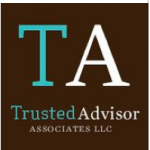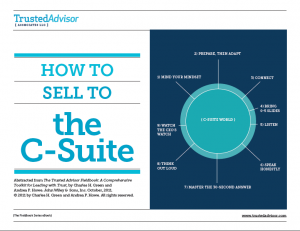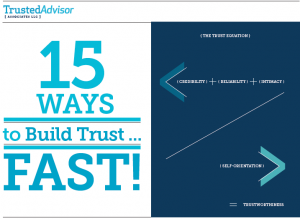We’re shining a spotlight on Trust Temperaments™ in our team over the next few months. Recently, I wrote about the six different temperaments we’ve identified in our research. Today, experience the temperaments in action through a conversation between a Catalyst and a Connector—our very own Charles H. Green and Andrea P. Howe.Listen in as they discuss facilitating programs and co-authoring a book.
Connectors and Catalysts
Connectors, like Andrea, are strongest in Intimacy and (low) Self-orientation. They can be described as:
- Magnetic and caring
- Those others trust with sensitive information
- Seeing the world from the point of view of people
Catalysts, like Charlie, combine strong Credibility with Intimacy. They:
- Love sparking—and gaining—new insights
- Like to make up their own rules
- Tend to see the world in terms of ideas
Setting the Stage
Sandy: Let’s start with workshops and presentations. You both have the same goal: to help people become powerfully trustworthy. You’re both terrific at what you do. Yet, you are very different temperaments. How do you prepare for a new workshop?
Andrea: Before the program itself, I like to build as much rapport with the people in the group as I can—through conversations, mini-focus groups, and email exchanges with participants sharing their current relationship challenges. I want every participant to get as much from the session as possible, and these connections give me a personal sense of the people I’ll be meeting as well as the issues they are facing.
As a Connector, I have a low (or favorable) Self-orientation score, and more than anything that means I manage my Self-orientation—constantly. Meeting the group as friends rather than strangers keeps my anxiety low and helps me to be fully present during a program.
Charlie: As a Catalyst, I value preparation too, but for a different reason. I like to know in advance about the group, the industry and the participants so I can see the big picture and get a sense of the issues facing them. I really want to know what’s going on at the macro level. This lets me make the training relevant in the moment to the participants, by saying things like: “You all know what it’s like to…”
Andrea: Yes, and you’re great at that. Though I know it’s important to connect to the big picture too, I don’t naturally lead with that in my preparation; I have to be intentional about it.
The Dress Rehearsal
Sandy: Ok, it’s nearly show time and very shortly you’re on stage. What do you do to get ready?
Charlie: It’s all about prep, and then ego deflation. I look over the agenda, check my handouts (the few that I use), and then work on calming my mind so that I can focus. I have a sort of prayer or meditation I do before I leave the hotel. I actually get on my knees and express my gratitude for being there on that day, and remind myself I’m there not for my own ego, but to be of service to the group.
Andrea: My approach is very different, with the same goal of being present for the participants. I create a very detailed agenda, and I work a lot on timing and transitions, which I review over and over. Then I leave the agenda behind. For me it’s like being a professional improviser: doing lots of rehearsal in order to be spontaneous on stage.
Charlie: Whatever the method, we both try to keep Self-orientation as low as possible so we can focus on personal growth—for ourselves and for every participant in the room. That’s what leads to being a better facilitator and a stronger leader.
Curtain Up
Sandy: What’s different about how you open up a program?
Andrea: I always start with some kind of introduction with a twist—something fun, engaging, and personal that gets people talking. I want people to get to know each other—and me—so they’re comfortable taking risks and stretching outside their comfort zone.
Charlie: And I’m more willing to skip this step and jump right in. I want to get them thinking, first and foremost. The Catalyst in me wants to spark new ideas both in and for the group.
Sandy: During a program, how do you manage the inevitable challenges of group dynamics?
Andrea: Andrea: One of the most important tools I use as a facilitator is our Name It and Claim It practice. If I lose concentration for a moment, or misunderstand someone, or say something stupid, right away I Name It and Claim It: “Oh boy, could I have gotten that more wrong?”
Just last week, I was leading a session and completely lost the group. We had an administrative task that took all 50 people in the room completely off course. I spoke to myself (out loud, into the mic): “OK, Andrea. Focus. Focus. Focus!” Putting my thoughts on loudspeaker that way got us all right back on track. Several people came up to me afterward to say that they learned something valuable by watching me simply being transparent about losing the group and my own focus.
Charlie: Being transparent is the savior of any speaker, and I’ve used it hundreds of times. Here’s another spin on it: being credible means if you don’t have an answer, you say so. I still sometimes have to say, “I’ve never thought of that question, and I don’t have the answer.” It’s also a good way to throw a question back to the group. After all, what I know is a lot less important than what they learn.
Tough Moments and Happy Endings
Andrea: As a Connector, it’s often hard for me to close off conversations when it’s time to move on. I want to give people as much time as they need to think through their issue out loud, and I want to nurture them all the way to their own insights. That isn’t always possible in the time we have. My temperament can play havoc with my carefully planned schedule!
Charlie: And I’m happy to stop them with a one-liner—the conclusion or insight. Sparking aha moments quickly is pure joy for a Catalyst. I like to hit people between the eyes. For me it’s a little tougher to stay in the emotional space for too long.
Andrea: I like to hit them between the eyes while holding hands.
Charlie: Yes, that’s it exactly. (laughing) In the end, we both get to the same result: helping participants grasp the material, generate aha moments, and take those insights into their own business and personal lives.
Sandy: Sounds like the key to success is in integrating who you are with the material you teach.
About a Book
Sandy: You recently sent the final manuscript for The Trusted Advisor Fieldbook to Wiley. As anyone who’s done it knows, writing a book is hard, and writing with another person sometimes makes it harder.
Andrea: Our different temperaments made for a stronger book in the end, but along the way the preferences of a Connector and those of a Catalyst definitely created conflict. Writing the fieldbook was natural for me in many ways because it’s all about making the trusted advisor material personal and useful to each and every reader.
Charlie: And for me, it was the hardest book I’ve ever written for that very same reason. It truly is a fieldbook— a keep-a-dog-eared-copy-with-you-at-all-times book about solving real problems. The focus is less on new insights—although there are plenty in the book—and more on translating concepts into everyday action. Not my strong suit.
Andrea: I think it’s true for everyone that working in ways that play to our natural temperament is energizing, while working against type can be exhausting. We both found this to be true with the fieldbook.
Writing the manuscript gave me an opportunity to reach out and ask people to contribute stories, to reconnect with clients old and new, to have a lot of personal interaction. It takes a village to write a book, and a Connector loves a good village!
Charlie: The exhausting part for me was the effort of working within the all-too-necessary framework of rules needed to get this book done—the standard formats, the numbered lists, the rigorous reviews. I like to create my own rules! Which, it turns out, is very Catalyst-like.
Andrea: You’re telling me! (laughing) You Catalysts also love a good debate; we Connectors—not so much. Going back and forth with you about chapter content, along with trying to keep things on track, definitely made for some trying times for us both.
Charlie: Would you do it again?
Andrea: Can you ask me that question in about six months?
The Trusted Advisor Fieldbook: A Comprehensive Toolkit for Leading with Trust, by Charles H. Green and Andrea P. Howe can be pre-ordered between now and October 31.
 When it comes to trust-building, stories are a powerful tool for both learning and change. Our new Story Time series brings you real, personal examples from business life that shed light on specific ways to lead with trust. Today’s anecdote zeroes in on an unexpected way to recover lost trust and appease an unhappy client: listening.
When it comes to trust-building, stories are a powerful tool for both learning and change. Our new Story Time series brings you real, personal examples from business life that shed light on specific ways to lead with trust. Today’s anecdote zeroes in on an unexpected way to recover lost trust and appease an unhappy client: listening.
 We’ve gone and done it.
We’ve gone and done it. When it comes to trust-building, stories are a powerful tool for both learning and change. Our new
When it comes to trust-building, stories are a powerful tool for both learning and change. Our new  We’re pleased to announce the release of our latest ebook:
We’re pleased to announce the release of our latest ebook: 

 In case you missed it, here’s your opportunity to get a copy of our latest eBook, “
In case you missed it, here’s your opportunity to get a copy of our latest eBook, “ We’re about halfway through our countdown of Trust Tips leading up to the release of “The Trusted Advisor Fieldbook: A Comprehensive Toolkit for Leading with Trust,”
We’re about halfway through our countdown of Trust Tips leading up to the release of “The Trusted Advisor Fieldbook: A Comprehensive Toolkit for Leading with Trust,”  We’re lighting up the twittersphere with a series of daily Trust Tips, counting down the work days until our upcoming book, “
We’re lighting up the twittersphere with a series of daily Trust Tips, counting down the work days until our upcoming book, “ As announced two weeks ago, we (Andrea P. Howe and Charles H. Green) are writing a book,
As announced two weeks ago, we (Andrea P. Howe and Charles H. Green) are writing a book,